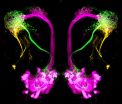Older adults over age 65 are at high risk for developing pneumonia, an inflammation of the lungs typically caused by infection. The most common type of pneumonia that occurs in this age group is caused by Streptococcus pneumoniae bacteria. As a person gets older, the immune system becomes weak, making them vulnerable to lung infection. Normally, the body fights this infection using specific white blood cells, known as neutrophils, that enter the lungs and kill the bacteria. If the numbers of neutrophils in the lungs are not well regulated, however, they can cause inflammation and damage. Aging can disrupt the ability of the body to regulate neutrophils.
"Earlier studies have shown that vitamin E can help regulate the aging body's immune system, but our present research is the first study to demonstrate that dietary vitamin E regulates neutrophil entry into the lungs in mice, and so dramatically reduces inflammation, and helps fight off infection by this common type of bacteria," said first author Elsa N. Bou Ghanem, Ph.D., postdoctoral scholar in the department of molecular biology and microbiology at Tufts University School of Medicine (TUSM).
The research team studied older, male mice before and after they were infected with the pneumonia-causing bacteria. Before these mice acquired the infection, they were fed different levels of vitamin E, specifically alpha-tocopherol, over a period of four weeks. One group of mice was fed the recommended amounts of vitamin E (the control group), while another group was fed elevated amounts of vitamin E (the experimental group).
The older mice fed a diet containing extra amounts of vitamin E, the equivalent to about 200 IU/day consumed by humans - about 10 times the Recommended Daily Allowance but well below the upper limit - were far more resistant to the bacteria than the older mice that had a normal amount of vitamin E in their diet.
To measure the differences in immune system function between the two groups of older mice, the researchers examined the lungs to assess damage, counted the number of bacteria in the lungs, and calculated the number of the white blood cells (neutrophils).
Compared to the mice that had normal amounts of vitamin E in their diet, the mice fed extra vitamin E had: 1,000 times fewer bacteria in their lungs Two times fewer the number of white blood cells (neutrophils)
The reduced numbers of bacteria and white blood cells resulted in less lung damage in the older mice who received extra vitamin E. These mice were able to control the infection as efficiently as young mice.
"A growing body of research suggests vitamin E could make up for the loss of immune response caused by aging," said co-senior author Simin Nikbin Meydani, D.V.M., Ph.D., director of the Jean Mayer USDA Human Nutrition Research Center on Aging, professor of Nutrition and immunology at the Friedman School of Nutrition Science and Policy, and member of the immunology program faculty at the Sackler School of Graduate Biomedical Sciences. "Whether vitamin E can help protect people against this type of pneumonia affecting older adults requires more research."
"Approximately 900,000 Americans get pneumonia each year; as many as 400,000 patients are hospitalized; and approximately 50,000 die. Vaccines are available but cannot protect everyone, and antibiotic resistance is a problem, particularly for older adults with pneumonia. Our work provides a better understanding of how nutrition can play a role in modulating how the immune system responds to infection," said co-senior author John M. Leong, M.D., Ph.D., professor and chair of the department of molecular biology and Microbiology at TUSM and member of both the immunology and molecular microbiology program faculties at the Sackler School.
A 2013 report on antibiotic resistance threats from the Centers for Disease Control and Prevention identified infections from Streptococcus pneumoniae as a serious concern that requires "prompt and sustained action." The bacterium causes 1.2 million drug-resistant infections, 19,000 excess hospitalizations, 7,000 deaths, and $96 million in excess medical costs per year. Older adults and young children are at most risk for developing these drug-resistant infections.
INFORMATION:
This work was supported in part by Tufts Collaborates Grant M230169 (to A.C., J.M.L., and S.N.M.), U.S. Department of Agriculture Contract 58-1950-0-014 (to S.N.M.), and the A.S.P.E.N. Rhoads Research Foundation 2013 and 2014 Abbott Nutrition grant (to E.N.B.G.).
Additional authors are Stacie Clark, a Ph.D., now a student in the molecular microbiology program at the Sackler School of Graduate Biomedical Sciences at Tufts; Xiaogang Du, Ph.D., formerly a postdoctoral scholar at the Jean Mayer USDA Human Nutrition Research Center on Aging at Tufts University; Dayong Wu, scientist at the Jean Mayer USDA Human Nutrition Research Center on Aging; and Andrew Camilli, Ph.D., Howard Hughes Medical Institute investigator, professor of molecular biology & microbiology at Tufts University School of Medicine, and member of the molecular microbiology program faculty at the Sackler School.
Bou Ghanem, E.N., Clark, S., Du, X., Wu, D., Camilli, A., Leong, J.M., Meydani, S.N. "The alpha-tocopherol form of vitamin E reverses age-associated susceptibility to Streptococcus pneumoniae lung infection by modulating pulmonary neutrophil recruitment." The Journal of Immunology, 1402401; published ahead of print December 15, 2014, doi:10.4049/jimmunol.140240
http://www.jimmunol.org/content/early/2014/12/13/jimmunol.1402401.abstract
About the Jean Mayer USDA Human Nutrition Research Center on Aging at Tufts University and the Friedman School of Nutrition Science and Policy
For three decades, the Jean Mayer USDA Human Nutrition Research Center on Aging at Tufts University has studied the relationship between good nutrition and good health in aging populations. Tufts research scientists work with federal agencies to establish the USDA Dietary Guidelines, the Dietary Reference Intakes, and other significant public policies. The Gerald J. and Dorothy R. Friedman School of Nutrition Science and Policy at Tufts University is the only independent school of nutrition in the United States. The school's eight degree programs - which focus on questions relating to nutrition and chronic diseases, molecular nutrition, agriculture and sustainability, food security, humanitarian assistance, public health nutrition, and food policy and economics - are renowned for the application of scientific research to national and international policy.
About Tufts University School of Medicine and the Sackler School of Graduate Biomedical Sciences
Tufts University School of Medicine and the Sackler School of Graduate Biomedical Sciences at Tufts University are international leaders in innovative medical and population health education and advanced research. Tufts University School of Medicine emphasizes rigorous fundamentals in a dynamic learning environment to educate physicians, scientists, and public health professionals to become leaders in their fields. The School of Medicine and the Sackler School are renowned for excellence in education in general medicine, the biomedical sciences, and public health, as well as for innovative research at the cellular, molecular, and population health level. Ranked among the top in the nation, the School of Medicine is affiliated with six major teaching hospitals and more than 30 health care facilities. Tufts University School of Medicine and the Sackler School undertake research that is consistently rated among the highest in the nation for its effect on the advancement of medical and prevention science.



